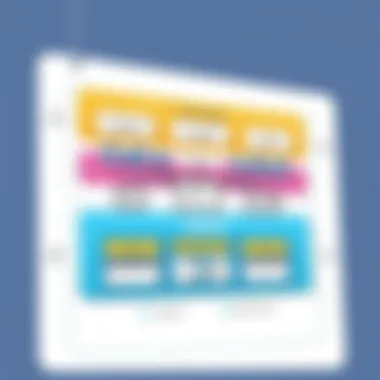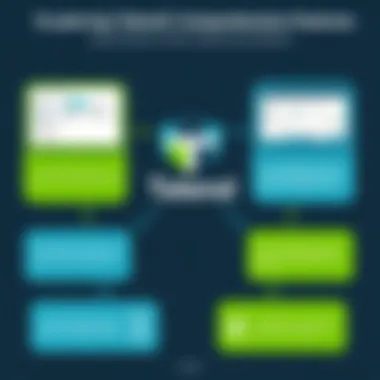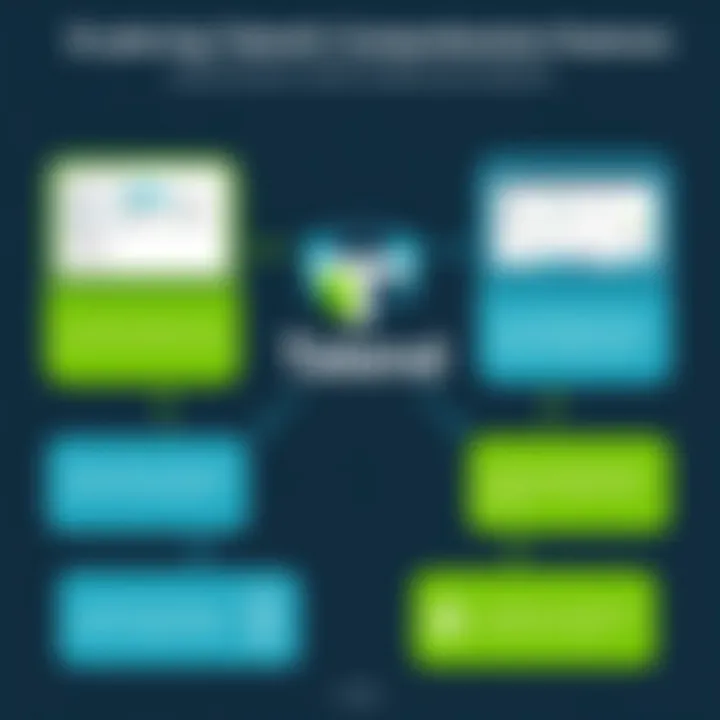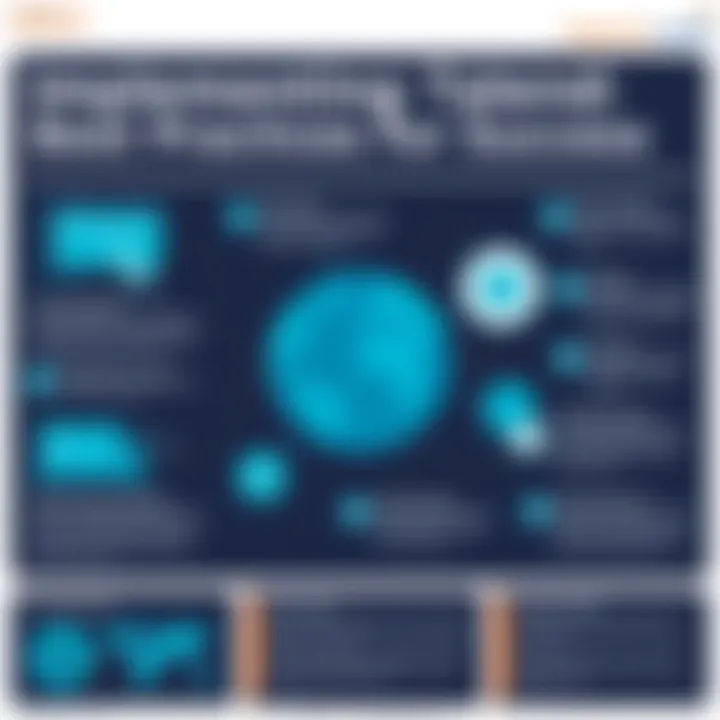Exploring Talend: A Comprehensive Guide to Data Integration


Intro
In today's data-driven world, the ability to integrate and manage data effectively can set a business apart from its competitors. This need brings attention to Talend, a tool that offers intricate solutions for data integration. Understanding how Talend operates within the vast landscape of data management is crucial for companies aiming to enhance their operations. This article will take a thorough look at Talend's features, its intended users, and the critical considerations for adopting such a tool.
In the following sections, we will explore the strengths and weaknesses of Talend, assess its various pricing models, and highlight the real-world applications across different industries. By providing a rounded perspective, industry advisors and decision-makers can make educated choices about whether Talend fits their needs.
Key Features and Functionalities
Comprehensive Overview
Talend stands out in the data integration sphere due to its robust set of features. It provides users a cloud-based platform that seamlessly supports on-premises systems as well as cloud data sources. This flexibility allows companies to adapt their data strategies as they evolve. Here are some of the notable features:
- ETL Capabilities: Talend specializes in Extract, Transform, Load (ETL). This process is essential for moving data from one system to another while ensuring it’s properly formatted for use.
- Data Quality Tools: Within its suite, Talend offers various tools designed to improve data accuracy and reliability, ensuring that decisions are founded on solid information.
- Support for Big Data: The platform integrates seamlessly with big data technologies, including Hadoop and Spark, catering to businesses that handle substantial data volumes.
- Collaboration Features: Teams can work together effectively with built-in collaboration tools, making it easy to share insights and streamline workflows.
These features are not just bells and whistles; they are core components that define Talend’s value proposition in today's competitive business environment.
Target Users
Talend is designed with diversity in mind. Its user base ranges from small startups to large enterprises, each benefiting from customized features that suit their specific needs.
- IT Professionals: System integrators and data engineers leverage Talend for its flexibility and ability to connect various systems.
- Business Analysts: Users focused on data analysis find Talend's data quality tools helpful for their reporting and analytics needs.
- Data Scientists: Those delving into advanced analytics rely on Talend to ensure that the data they work with is clean and well-organized.
In essence, Talend caters to any organization that recognizes the importance of data in driving successful business outcomes.
Pricing Models and Cost Analysis
Breakdown of Pricing Tiers
Talend operates on a subscription-based model, which can vary depending on the functionalities a company needs. Consider these typical tiers:
- Free Open Studio: For startups or small businesses just beginning their data integration journey. This version provides essential ETL features.
- Talend Cloud: Intended for organizations that require cloud functionality, allowing for greater scalability and flexibility, priced based on usage.
- Talend Data Fabric: This option combines various Talend services into one package, ideal for larger enterprises aiming for a comprehensive solution.
Additional Costs to Consider
While the base pricing provides a starting point, additional costs may arise:
- Training and Onboarding: Investing in training sessions can be crucial for successful implementation.
- Upgrades or Customization: Businesses may find themselves needing tailored features, leading to further expenses.
- Support Plans: Depending on the selected tier, additional fees may be required for premium support options.
The investment in Talend, although varied, is reflective of the multifunctional capabilities it promises to deliver.
"A well-integrated data system enables businesses to make informed and timely decisions that can lead to competitive advantages."
As we move forward, the next sections will focus on Talend's strengths, limitations, and how it compares with other tools in the market.
Understanding Talend
In the fast-paced world of data management, understanding Talend becomes critical for organizations looking to optimize their data integration strategies. Talend offers a holistic platform aimed at simplifying and enhancing the way data flows through various systems. Its importance lies not just in its technical capabilities but in how it meets the specific challenges faced by businesses today. By diving into the world of Talend, decision-makers gain insight into how they can leverage this tool to harness data effectively, improve operational efficiencies, and derive actionable intelligence.
Intro to Talend
Talend began as an open-source project and has transformed into a highly regarded data integration platform over the years. With its core philosophy revolving around ease of use and accessibility, Talend caters to a broad spectrum of users, from IT professionals to business analysts. This means that many people with varied skill levels can participate in data integration processes, which, in turn, demystifies data handling across teams.
One of the significant advantages of Talend is its robust community support, which provides a wealth of resources, guidance, and shared experiences. Organizations are not just purchasing a software tool; they are entering a vibrant ecosystem where knowledge-sharing thrives. Furthermore, Talend's intuitive design lowers the barrier to entry for users unfamiliar with complex coding, thus facilitating a more collaborative approach to data management. Meanwhile, organizations can focus less on battling integration challenges and more on deriving value from their data.
The Evolution of Data Integration Platforms
A look back at the landscape of data integration platforms reveals a gradual yet profound evolution. It wasn't too long ago that businesses relied heavily on rigid, outdated systems that lacked flexibility and adaptability to meet their ever-changing data needs. The move from on-premises solutions to cloud-based services initiated a significant shift, paving the way for platforms like Talend. This evolutionary process can be associated with several key trends:
- Increased Data Volumes: As organizations collect more data across various sources, the need for a seamless integration solution becomes crucial.
- Real-Time Analytics: The demand for immediate insights from data has driven the evolution of integration methods, prompting a shift towards solutions that support real-time data processing.
- User-Friendly Interfaces: The rise of data integration tools with intuitive user interfaces has made it easier for more users to engage with data without needing extensive technical training.
- API Integration: Modern platforms are increasingly focused on API-based integrations, allowing for easy connections to different applications and services.
As a result of these factors, Talend and similar platforms have emerged as vital components of the data strategy for organizations, enabling them to stay competitive and agile in a data-driven market. Talend's ability to adapt and align with these evolving trends positions it as a key player in the realm of data integration.
Core Features of Talend
Understanding the core features of Talend is crucial for decision-makers and IT professionals keen on optimizing their data integration strategies. Talend offers a variety of functionalities, making it a robust platform that caters to diverse business needs. This section will unpack the nuances of Talend's offerings, focusing on key elements such as its open-source nature, data integration and ETL capabilities, data quality management, and real-time processing features. Grasping these characteristics can lead to more informed decisions in tool selection and implementation.
Open Source vs. Commercial Offerings
Talend operates on both open-source and commercial fronts, presenting a dual nature that appeals to a broad audience. The open-source model allows users to access a base version of the platform without any licensing fees. This feature is particularly attractive to startups and small businesses keen on testing the waters before making any long-term commitments. Additionally, many users appreciate the community support that comes with the open-source model, allowing individuals to exchange ideas and solutions without cost barriers.
Conversely, Talend’s commercial offerings provide advanced capabilities and dedicated support that simply cannot be found in the open-source version. These commercial licenses are packed with enhanced features and performance metrics, making them suitable for larger enterprises with substantial data needs. The potential for scalability and reliability in commercial deployments is notably higher, offering peace of mind to organizations handling sensitive or critical data.


"The flexibility to choose between open-source and commercial options is a game-changer in the data integration landscape." - Data Integration Expert
Data Integration and ETL Capabilities
Data integration is at the heart of Talend’s value proposition. The platform excels in Extract, Transform, Load (ETL) processes, enabling organizations to gather data from various sources, transform it into a usable format, and load it into data warehouses seamlessly. Talend's intuitive interface facilitates these complex processes, making it less daunting for users who may not have extensive technical backgrounds.
Some standout features include:
- Pre-built connectors: Talend provides a plethora of connectors to various databases, cloud services, and APIs, simplifying the integration process.
- Visual data mapping tools: These tools help users visualize data flows, enhancing comprehension of data relationships and hierarchies.
- Job orchestration capabilities: Talend allows users to manage and schedule data jobs effortlessly, ensuring timely updates to datasets.
The robust ETL capabilities empower organizations to maintain clean and consistent data across systems, which is critical for achieving accurate analytics and reporting.
Data Quality Management Tools
An often overlooked aspect of data integration is data quality, and Talend addresses this with a suite of data quality management tools. Maintaining high-quality data is non-negotiable in today’s data-driven environment. Talend’s features in this domain include:
- Data profiling: Users can analyze data to discover inconsistencies, duplications, and inaccuracies before they escalate into major issues.
- Data cleansing: Automated processes help eliminate errors and standardize data formats, ensuring uniformity across datasets.
- Validation checks: Talend includes tools to validate data against set parameters, providing an added layer of assurance.
These tools not only enhance data accuracy but also bolster trust in data-driven decision-making processes, making them invaluable to enterprises.
Real-time Data Processing Features
In a world where data is continuously generated, real-time data processing capabilities are crucial for many organizations. Talend permits near real-time processing, allowing businesses to act on fresh data inputs instantaneously. This immediacy can significantly impact operational effectiveness and customer experience.
Key advantages include:
- Instant insights: Decision-makers can access up-to-the-minute data, facilitating timely responses to market movements or customer needs.
- Streamlined operations: Real-time processing minimizes delays in data availability, thus improving overall productivity.
- Enhanced user engagement: Organizations can personalize experiences based on live data, fostering stronger relationships with customers.
The ability to manage and utilize data in real time is a noted competitive advantage for firms leveraging Talend effectively.
With a deep dive into the core features of Talend, we can appreciate how each aspect interconnects to form a comprehensive data integration solution. As Talend continues to evolve, understanding these strengths will be essential for organizations aiming to harness their data effectively.
Architecture and Deployment Models
Understanding the architecture and deployment models is crucial for those looking to implement and optimize Talend. This section unearthed how Talend structures its technology and offers various options for deployment, directly influencing integration efficiency and overall operational strategy.
The Technical Framework of Talend
Talend’s technical framework is built on a versatile architecture that emphasizes scalability and efficiency, tailored to meet the diverse demands of data integration. At its core, Talend utilizes a modular architecture, separating different components that work together harmoniously while allowing modification or expansion as necessary. This ensures that organizations can adapt Talend’s capabilities in line with their evolving data environment.
Key Components of Talend's Framework:
- Talend Studio: The development environment where users design data integration jobs with a user-friendly interface, allowing drag-and-drop functionalities.
- Talend Server: The centralized server that manages and schedules the execution of data jobs, providing control over processing and resources.
- Repository: For storing all project files, promoting collaboration and version control among team members.
One of the standout features of Talend's framework is its use of an open-source model. This encourages a strong community involvement, leading to continuous enhancements and availability of a rich library of components compatible with various databases and applications.
Furthermore, Talend supports Data Governance through its architecture, enabling organizations to ensure that their data is accurate, consistent, and secure. This is particularly important in sectors burdened with compliance and regulatory demands.
Overall, Talend’s technical framework is designed with flexibility and robustness in mind, allowing organizations to craft tailored data workflows and address unique business challenges.
Cloud vs. On-Premises Solutions
The decision between cloud and on-premises deployment options is pivotal for businesses considering Talend. Each solution presents distinct advantages and challenges. By evaluating both models, organizations can align their choice with their operational needs and strategic goals.
Cloud Solutions:
- Accessibility: Talend’s cloud offerings provide users with easy access from anywhere, facilitating remote collaboration and quick deployment of services.
- Scalability: The cloud model allows organizations to adjust their resources dynamically, meaning they can scale up during peak times without the need for physical infrastructure investment.
- Cost-Effective: Often, cloud solutions work on a pay-as-you-go basis, which can be more economical for businesses not ready to commit to large upfront costs.
However, there are considerations regarding data security and compliance, particularly for organizations managing sensitive information.
On-Premises Solutions:
- Control: With on-premises deployment, companies have complete control over their data and the environment it operates in. This is critical for industries with stringent data protection regulations.
- Performance: For enterprises handling massive volumes of data, on-premises systems may offer superior speed and latency compared to cloud solutions.
- Integration: Organizations with existing on-premises IT investments might find it easier to integrate Talend into their established systems efficiently.
Nonetheless, the on-premises approach requires more significant investments in hardware, maintenance, and skilled personnel, which can deter some smaller organizations.
In the end, the choice between the cloud and on-premises solutions must be guided by a thorough analysis of an organization’s specific needs, budget constraints, and long-term IT strategy. That aligns well with Talend’s mission to provide adaptable data integration solutions for businesses of varying sizes and operational scopes.
"Selecting the right deployment model can be as crucial as the tool itself; it shapes how effectively an organization can leverage its data."
This nuanced understanding of Talend’s architecture and deployment options arms decision-makers with the insights needed to harness data integration capabilities effectively, ensuring they not only keep pace but also set the beat in their respective industries.
For additional resources, check out Wikipedia on Data Integration and Britannica on Cloud Computing.


Incorporating these deployment models within Talend's framework ensures that organizations can deploy the best strategies to meet their immediate needs, while remaining flexible enough to adapt to the uncharted territories of future data landscapes.
Applications of Talend
The application of Talend within various sectors has become increasingly vital. Organizations are realizing the significance of extracting timely, relevant insights from a plethora of data sources. With its capability to streamline data processing and improve integration, Talend stands out as a go-to solution for many enterprises. The flexibility it offers to connect various data systems means that companies can respond quickly to market changes, ultimately enhancing their competitiveness.
Industry-specific Use Cases
Talend's versatility shines brightly across different industries, each utilizing its strengths in unique ways. Here are a few examples:
- Healthcare: This sector uses Talend for integrating patient records from various systems. By consolidating data, healthcare providers achieve better patient outcomes through comprehensive views of their patients' histories. For example, a major hospital network managed to reduce patient wait times by 30% after implementing Talend’s data integration solutions.
- Finance: In banking, Talend plays a crucial role in compliance reporting and fraud detection. Financial institutions use Talend to aggregate transaction data from disparate sources, helping them identify unusual patterns that might indicate fraudulent activity. One prominent bank reported a 40% increase in the efficiency of its compliance checks upon adopting Talend’s platform.
- Retail: Talend assists retailers in integrating point-of-sale data with inventory management systems. Through real-time data processing, businesses can optimize their stock levels, reduce waste, and increase sales opportunities. A fashion brand leveraged Talend to improve its inventory turnover rates, demonstrating increased responsiveness to customer demand.
- Telecommunications: By providing seamless data integration for network management systems, Talend aids telecom providers in troubleshooting network issues faster. This capability ensures that service interruptions are minimized, providing a smoother experience for customers.
These industry-specific use cases underscore how Talend’s data integration platform is not a one-size-fits-all solution, but rather a tool that adapts to the specific needs and nuances of each sector.
Integration with Other Software Solutions
One of Talend's remarkable features is its ability to integrate with other software solutions seamlessly. This is essential in today’s business environment, where organizations rely on a suite of applications to drive their operations. Talend supports various integrations, enabling businesses to enhance functionality without removing existing tools from their tech stack.
- CRM Systems: Integrating Talend with Customer Relationship Management (CRM) systems like Salesforce permits automatic data updates and synchronization. Customer data captured in CRM can be enriched with additional metrics from other platforms—allowing for a more detailed analysis of customer behavior.
- Enterprise Resource Planning (ERP): Integration with ERP systems ensures that financial, supply chain, and operational data flows seamlessly across different business units. This synchronization allows for holistic views of essential business functions, helping management make informed decisions.
- Business Intelligence Tools: Talend works well with various business intelligence solutions, such as Tableau and Power BI. The integration allows for smoother data extraction and visualization, making it easier for analysts to generate insights from complex datasets quickly.
"Ease of integration is critical when selecting a data management platform. Talend’s compatibility with other popular software stands out for many organizations."
- Cloud Services: Given the rise of cloud computing, Talend offers integration capabilities with cloud platforms like Amazon Web Services, Google Cloud Platform, and Microsoft Azure. The movement of data between on-premises systems and cloud-based services is essential for businesses looking to leverage the benefits of cloud technology.
Through these integrations, organizations can fully leverage the capabilities of Talend to create a robust data ecosystem, fostering agility and enhancing decision-making processes.
Strengths and Limitations of Talend
When it comes to data integration and management, understanding Talend's strengths and limitations is crucial for businesses of all sizes. The relevance of this topic cannot be overstated, especially as organizations increasingly rely on data-driven decisions to stay competitive. Here, we will break down some key elements that showcase what Talend offers its users, while also touching on the considerations that potential adopters must keep in mind.
Advantages for Users
Talend stands out in the crowded field of data integration tools for several reasons. First and foremost, its open-source model allows any business, regardless of size, to access powerful data management capabilities without the hefty price tag often associated with proprietary software. Here are some key advantages:
- User-friendly Interface: Talend presents a modern, intuitive interface that makes it easier for users to design workflows. This can lead to quicker deployment of data solutions.
- Comprehensive Data Integration: With its broad set of tools, Talend allows for smooth integration across various sources, including cloud services, APIs, and enterprise applications. The flexibility to connect to multiple data sources cannot be understated.
- Strong ETL Processes: Extract, Transform, Load (ETL) capabilities are robust, enabling users to efficiently manage large volumes of data. Talend automates many processes, helping organizations save time while minimizing manual errors.
- Community Support: Being open-source, Talend has built a strong community around it. Users can share ideas, solutions, and custom components, providing an additional layer of support.
"The open-source nature of Talend not only enhances collaboration but also minimizes barriers for entry, allowing even small businesses to harness the power of data integration."
Challenges and Considerations
However, no tool is without its drawbacks, and Talend is no exception. Since it caters to a diverse user base, understanding its limitations is just as important as recognizing its strengths. Some challenges to consider include:
- Learning Curve: Despite its user-friendly nature, some users may still face a learning curve, particularly those who lack experience with data integration. Initial setup and configuration can take time.
- Performance Issues: As with any ETL solution, performance may suffer with exceptionally large data sets or complex transformations, especially if not properly optimized.
- Licensing Costs for Enterprise Features: While the open-source version is free, businesses looking for advanced features will need to invest in the professional edition, which can become costly over time.
- Support Limitations: Although community support is a strong point, reliance on forums and peer advice may not be sufficient for organizations needing urgent help or dedicated technical support.
In summary, while Talend offers robust data integration solutions with several advantages, it also comes with challenges that potential users must weigh against their specific business needs. Being informed about both sides equips decision-makers to better navigate the integration landscape and leverage Talend to its fullest potential.
Evaluating User Experience
Evaluating user experience in the context of Talend is paramount. This process goes beyond mere software usability; it encapsulates the intricate ways users interact with the platform. Insight into user experiences can shed light on how Talend can fulfill or fall short of its promises. When organizations invest in a data integration tool, understanding the user journey helps in recognizing which features stand out and which aspects may need finetuning.
The benefits of focusing on user experience are multifaceted. A positive user experience can lead to higher adoption rates and sustained user engagement. Moreover, it can directly influence data integrity, operational efficiency, and ultimately, decision-making within organizations. For decision-makers and IT professionals, grasping the nuances of user experience also translates into actionable strategies for training and support.
In navigating the landscape of data integration, being attuned to user feedback becomes an invaluable aspect of staying relevant and competitive. This section will delve into specific testimonials and industry feedback, positioning Talend not just as a tool but as a solution shaped by its users.
Best Practices for Implementation
Implementing Talend effectively is not just about installing the software or configuring the environment. It’s akin to setting the stage for a grand performance; meticulous planning and strategy are crucial for a seamless show. This section explores best practices that can enhance the implementation process, ensuring that organizations maximize Talend’s capabilities to integrate and manage data.
Planning and Strategy Development
The foundation of a successful Talend implementation lies in thorough planning. Organizations should align their data integration strategies with wider business goals. Here are some critical elements to consider:
- Define Clear Objectives: What do you aim to achieve with Talend? Is it to improve data quality, streamline data workflows, or boost analytics capabilities? Establishing clear objectives not only helps in selecting the right tools but also measures success later on.
- Stakeholder Involvement: Engage a diverse group of stakeholders from different departments. Their varied perspectives can lead to more comprehensive planning and help identify potential hiccups early on. This collaboration fosters a sense of ownership, which is crucial for successful implementation.
- Assess Existing Infrastructure: Understand the current data architecture and integration challenges. This assessment provides a baseline, allowing for a more efficient integration of Talend with existing systems.
- Pilot Testing: Before a full-scale rollout, conducting pilot tests can unveil unforeseen issues. This trial run allows teams to gather insights and make necessary adjustments, ultimately saving time and resources in the long run.
Planning isn't a one-and-done deal; it’s an ongoing process that evolves. Adapting to new data needs and technologies is essential in today’s rapidly changing environment.
Training and Onboarding Processes
Once the planning phase is solid, the next step is ensuring that your team can navigate Talend's platform effectively. Here’s where training and onboarding come into play:
- Tailored Training Programs: One-size-fits-all training rarely works. Tailor training sessions to meet varying levels of technical expertise within your team. This could range from in-depth training for advanced users to basic sessions for newcomers.
- Utilize Resources: Leverage Talend’s training resources, like webinars and documentation, as well as community forums. Websites like reddit.com and the official Talend Community are treasure troves of information.
- Hands-on Practice: Theoretical knowledge is good, but practical skills make the difference. Encourage your team to engage in hands-on exercises. Setting up a sandbox environment can help users familiarize themselves with the interface and functionalities without the fear of making irreversible changes.
- Continuous Learning: The data landscape is never static, and neither is Talend. Encourage a culture of continuous learning through regular workshops and updated training materials. This practice ensures that your team is not just well-versed in Talend, but also evolves with it.
Successful implementation of Talend isn’t merely about technology; it’s also about people and processes. By following these best practices, organizations can lay a sturdy groundwork for data integration efforts that not only serve current needs but also pave the way for future growth and adaptation.


"A project well-planned is a project half-executed."
The Competitive Landscape
In today's data-centric world, understanding the competitive landscape is not just a luxury; it's a necessity. Organizations looking to adopt a data integration platform must grapple with various options available in the market. Each platform comes with its unique set of features, strengths, and weaknesses. Navigating this landscape helps decision-makers, IT professionals, and entrepreneurs find the best fit for their specific data integration needs.
The competitive landscape allows stakeholders to make informed choices based on a mix of factors such as functionality, scalability, user experience, and cost-effectiveness. This clarity helps businesses avoid pitfalls that can arise from jumping into a decision without weighing all the options carefully. Assessing the competition also uncovers industry trends that are transforming how organizations utilize data today.
Comparative Analysis with Other Data Integration Tools
When conducting a comparative analysis, Talend stands its ground among various industry heavyweights like Informatica, Microsoft Azure Data Factory, and Apache NiFi, to name a few. Unlike some tools that might focus exclusively on cloud or on-premises solutions, Talend offers a hybrid approach, giving users the flexibility to deploy as they see fit.
Key Elements in Comparative Analysis:
- Functionality: Does it provide robust ETL capabilities?
- Scalability: Can it grow with your organization?
- User Experience: How intuitive is the interface?
- Support and Community Engagement: Is there a strong community or support system?
While Informatica may be the go-to choice for larger enterprises, Talend appeals to small and medium businesses due to its open-source offering. Every organization has distinct needs, and Talend’s cost-effective model makes it easier for smaller players to enter the data integration game without breaking the bank.
"A well-rounded choice is crucial in a landscape where one size does not fit all."
Identifying Key Competitors
In competitive analysis, identifying key competitors goes beyond just naming them; it means understanding what sets these rivals apart and how they align with market demands. Key competitors include:
- Informatica: Known for its comprehensive data management suite, it excels in robustness but often at a steeper cost.
- Microsoft Azure Data Factory: A strong player for those embedded within Microsoft’s ecosystem, it’s attractive for Azure users but may present challenges for others looking for flexibility.
- Apache NiFi: An open-source alternative that thrives in real-time data processing, though it may require more technical expertise to implement effectively.
These competitors shape the narrative around Talend. By examining their specific offerings, users can glean how Talend positions itself—including its strengths and limitations. Such an understanding not only helps in making a choice but also informs potential future enhancements for the selected platform.
Future Trends in Data Integration
The world of data integration is always on the move. With the ever-growing data landscape, organizations need to stay ahead of the curve to harness the full potential of their data assets. This section dives into crucial shifts and trends that are shaping the future of data integration. Adapting to these evolving dynamics is vital for maintaining a competitive edge in today’s tech-centric markets.
Adapting to Evolving Data Needs
In recent years, the amount of data generated and collected has surged astronomically. Organizations now have data pouring in from various channels including social media, IoT devices, and traditional business operations. It's like trying to drink from a fire hose—overwhelming yet essential. To respond effectively to this influx, companies must rethink their integration strategies.
Flexibility has become a keyword here. Solutions must adapt in real-time, ensuring data is not just collected but also analyzed and utilized efficiently. This means moving towards more agile, scalable integration solutions that can handle varying types of data. For instance, the emergence of hybrid models allows businesses to combine on-premises data centers with cloud storage, resulting in more robust frameworks.
"In a data-driven world, relevance is lost without the capability to integrate and interpret data quickly and accurately."
Key considerations for adapting to these evolving data needs include:
- Scalability: Systems should grow along with the data. Solutions such as Talend provide scalable architectures that can accommodate increasing data volumes.
- Interoperability: Different systems must be able to communicate seamlessly. This has sparked a shift towards open standards that enhance cross-compatibility.
- Real-time Processing: Quick access to data is no longer optional. Businesses demand real-time insights to make informed decisions and maintain agility.
The Role of Artificial Intelligence and Machine Learning
Artificial Intelligence (AI) and Machine Learning (ML) are game changers in the field of data integration. These technologies are increasingly seen as vital components that enhance the efficacy of data processing and analysis. AI can sift through vast quantities of data faster than any human ever could, allowing organizations to spotlight actionable insights and make predictive analyses.
For instance, Talend employs AI to automate mundane tasks in the data integration process, freeing teams to focus on high-level analyses. By intelligently handling data quality issues or transforming data formats, AI elevates the integration front—ensuring data is always accurate and ready for use.
Moreover, machine learning algorithms can predict future data trends based on historical data, enabling businesses to plan strategically. A couple of impacts of AI and ML in this context are:
- Predictive Analytics: Businesses make data-driven forecasts that enhance strategic decision-making.
- Anomaly Detection: AI can automatically identify and flag errors or inconsistencies in data sets.
Looking ahead, organizations that leverage AI and ML technologies will likely find themselves at a significant advantage, able to respond to data needs more efficiently than ever before.
In summary, as the landscape of data integration evolves, recognizing and addressing these trends is essential. Organizations looking to thrive must adopt flexible solutions that incorporate modern technologies, ensuring they can adapt swiftly to the ever-changing data environment.
Culmination and Recommendations
In closing, understanding Talend's role in data integration is crucial for companies aiming to enhance their data management strategies. Behind the complexity of data integration lies the opportunity to streamline processes and drive better decision-making. The recommendations highlighted in this article can guide decision-makers in leveraging Talend most effectively.
One key takeaway is the flexibility that Talend offers—adapting to both large and small organizations. This makes it an appealing choice, especially as businesses increasingly recognize the need for agile data solutions. Implementing Talend isn't just about choosing a tool; it's about embracing a data culture that leverages actionable insights for competitive advantage.
Some considerations include:
- Skill Development: Invest in training and certifications for your team to maximize Talend's features.
- Integration with Existing Systems: Ensure Talend can smoothly integrate with your current software landscape. A disjointed integration can lead to more harm than good.
- Scalability: Determine how Talend can grow with your organization. The modular aspects should support evolving data needs.
- Cost versus Value Analysis: Balance your investment against the tangible benefits Talend can bring, ensuring that the solution aligns with your strategic goals.
Ultimately, a holistic approach is recommended; one that includes not only Talend's integration features but also the alignment of data practices with business objectives.
By continually assessing the capabilities of Talend against the backdrop of changing data demands, decision-makers can ensure they stay at the forefront of innovation in data management.
Key Takeaways for Decision Makers
- Versatility: Talend is highly adaptable for various types of organizations, catering to differing data needs without losing effectiveness.
- Integration Ease: Ensure compatibility with existing systems to capitalize on Talend's full potential.
- Training: Prioritize skill-building to ensure teams can effectively navigate and utilize the platform.
- Cost Efficiency: Weigh initial costs against long-term benefits to assess value accurately.
- Stay Agile: Be prepared to re-evaluate your integration strategies as the company's needs grow and change.
Final Thoughts on Talend's Position in Data Integration
Talend stands out as a robust player in the ever-changing landscape of data integration. As organizations move toward data-driven decision-making, platforms like Talend provide the foundational tools necessary to harness data's true potential. From its unique blend of open-source access to enterprise-grade features, it is positioned to effectively address the complexities of modern data environments.
"The true value of data lies not in its collection but in its insightful application."
This focuses Talend on crafting solutions that not only integrate but also elevate data usage to strategic levels. For professionals in the field, Talend represents more than just technology; it's a gateway to smarter, faster decision-making. Keeping pace with innovations in data practices will be key for maintaining a competitive edge.















